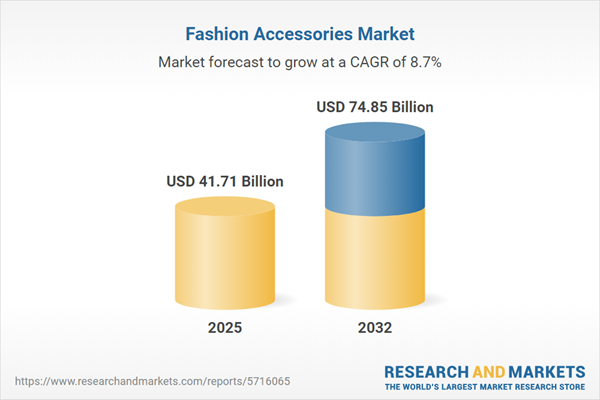Speak directly to the analyst to clarify any post sales queries you may have.
The global fashion accessories market is undergoing transformation as digital innovation meets evolving consumer needs and agile supply networks. For senior decision-makers, staying informed is essential to capitalize on new opportunities, mitigate risks, and maintain a competitive edge.
Market Snapshot: Fashion Accessories Market Size and Growth
The fashion accessories market recorded growth from USD 38.43 billion in 2024 to USD 41.71 billion in 2025, representing a compound annual growth rate of 8.68%. Projections indicate the sector will reach USD 74.85 billion by 2032. This ongoing momentum demonstrates robust demand, consistent investor confidence, and emphasizes the importance of continual product and distribution innovation. The current climate encourages strategic market planning as senior leaders aim to anticipate changes and drive value while global competition escalates.
Scope & Segmentation of the Fashion Accessories Market
This research study enables executive teams to benchmark competitors, evaluate operational strategies, and assess market entry options in both established and growth markets. The segmentation framework addresses opportunities and challenges across key dimensions:
- Product Types: Belts (fabric, leather), eyewear (corrective and sun protection), handbags and wallets (clutches, backpacks, totes, holders), hats and caps, jewelry (fashion, fine, wearable tech), and scarves and shawls made from various materials. These segments highlight innovation diversity and consumer appeal.
- Distribution Channels: Branded stores, department outlets, specialty retailers, direct-to-consumer platforms, e-commerce marketplaces, and social commerce. Each channel supports connectivity with global buyers, revealing the increasing role of both digital and physical retail environments.
- Price Ranges: Discount and fast fashion, accessible mid-range, premium-mass, and luxury offerings facilitate targeted engagement of diverse consumer segments.
- Demographics: Analysis includes gender (men, women, unisex) and age groups (children, teens, young adults, maturity segments), reflecting the widespread reach and adaptability of accessory categories.
- Materials: Inputs include cotton, silk, wool, genuine and synthetic leather, metals (gold, silver), plastics, and rubber. Understanding sourcing options is critical, with sustainability influencing procurement decisions.
- Key Geographic Regions: Americas, Europe, Middle East & Africa, and Asia-Pacific each present distinct consumption patterns and regional dynamics relevant for customized growth strategies.
- Leading Companies: Strategies from LVMH Moët Hennessy Louis Vuitton SE, EssilorLuxottica SA, Kering SA, Compagnie Financière Richemont SA, Chanel S.A., Hermès International SCA, The Swatch Group AG, Tapestry, Inc., Capri Holdings Limited, and Prada S.p.A. provide benchmarking insights and direction for strategic alignment.
Key Takeaways for Senior Executives
- Product portfolios are adapting to customization preferences and functional improvements, guided by sustainability considerations and evolving consumer values.
- Adoption of digital technologies, such as augmented reality for virtual try-ons, AI-driven product recommendations, and blockchain-based traceability, is reshaping industry operations and competitive positioning.
- Omnichannel models are fostering an integrated customer journey, blending e-commerce innovations with established retail practices to enhance market reach and responsiveness.
- Greater supply chain transparency and a focus on environmental accountability reduce operational exposure and strengthen corporate reputation as global standards become more stringent.
- Regional strategies are leveraging advanced analytics and collaboration with technology partners, enabling tailored solutions that reflect regulatory differences and local consumer preferences.
Impact of 2025 United States Tariff Measures
Recent U.S. tariff measures are influencing brands to revise and broaden sourcing strategies, especially regarding leather, metals, and synthetic alternatives. Organizations are expanding their supplier bases and adapting sourcing locations to manage these changes. Agility in procurement processes and close monitoring of trade policy developments are now key to safeguarding global operations.
Fashion Accessories Market: Research Methodology & Data Sources
This analysis employs a dual-method approach, incorporating both qualitative and quantitative insight from trusted industry sources, regulatory documents, executive interviews, and direct end-user surveys. Rigorous cross-verification and validation protocols ensure the accuracy and reliability of the findings.
Why This Report Matters: Strategic Value for Fashion Accessories Market Stakeholders
- Provides actionable intelligence on disruptive trends and technology adoption to help executives adapt strategies and respond to market pressures.
- Enables comprehensive benchmarking across both established and emerging brands, offering segment-specific and regional context for positioning and performance improvement.
- Guides investment planning by clarifying compliance shifts and evolving supply and distribution landscapes, empowering leaders to navigate uncertainty and pursue growth opportunities.
Conclusion
This report empowers senior leaders to address evolving market challenges, shape successful expansion plans, and create sustained organizational value within the fashion accessories sector.
Additional Product Information:
- Purchase of this report includes 1 year online access with quarterly updates.
- This report can be updated on request. Please contact our Customer Experience team using the Ask a Question widget on our website.
Table of Contents
3. Executive Summary
4. Market Overview
7. Cumulative Impact of Artificial Intelligence 2025
List of Figures
Samples

LOADING...
Companies Mentioned
The key companies profiled in this Fashion Accessories market report include:- LVMH Moët Hennessy Louis Vuitton SE
- EssilorLuxottica SA
- Kering SA
- Compagnie Financière Richemont SA
- Chanel S.A.
- Hermès International SCA
- The Swatch Group AG
- Tapestry, Inc.
- Capri Holdings Limited
- Prada S.p.A.
Table Information
| Report Attribute | Details |
|---|---|
| No. of Pages | 194 |
| Published | October 2025 |
| Forecast Period | 2025 - 2032 |
| Estimated Market Value ( USD | $ 41.71 Billion |
| Forecasted Market Value ( USD | $ 74.85 Billion |
| Compound Annual Growth Rate | 8.6% |
| Regions Covered | Global |
| No. of Companies Mentioned | 11 |









